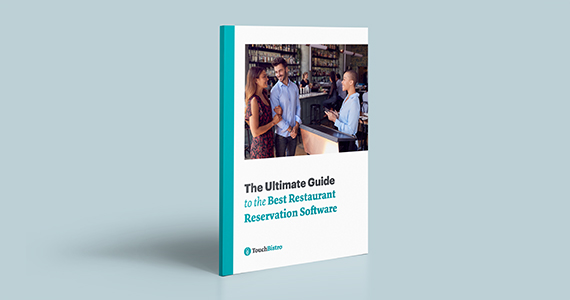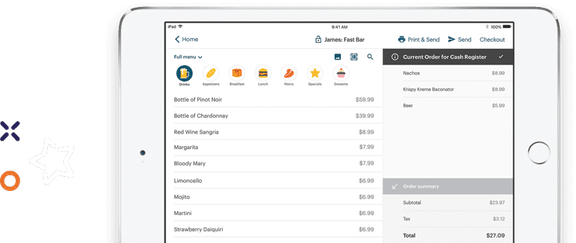Restaurant reservation systems have become essential to running a successful restaurant.
Restaurant reservation systems are specifically designed to help to automate the tedious process of taking and managing bookings. With modern restaurant reservation software, guests can reserve tables online at any time and owners are alerted to any new reservations, cancellations, or no-shows. Many reservation systems also include additional features, such as digital waitlists, diner profiles, capacity management, and more.
However, not all restaurant reservation systems are created equal. Today, there are dozens of different reservation platforms to choose from, each with its own strengths and weaknesses. While more choice is great for restaurateurs with varying needs, weighing all the different options can take a considerable amount of time and energy.
That’s where our 2024 guide to the best restaurant reservation systems comes in. With in-depth reviews of all the top restaurant reservation systems (including our own), this guide will help you narrow down the best reservation software for your specific business.
In each review, you’ll find:
- A basic overview of each of the top restaurant reservation systems
- Each system’s strengths and weaknesses
- Restaurant software pricing and other fees
- The ideal reservation solution for each type of restaurant
We know that every restaurant is unique and this guide is designed to help you cut through the noise to find the best restaurant reservation software for your specific venue.

Compare the top restaurant reservation systems on features, integrations, pricing, and more.
TouchBistro Reservations
Overview
TouchBistro Reservations is a complete reservation and guest management platform designed to help restaurateurs tailor every guest experience, while managing operations with ease. TouchBistro Reservations is available to venues in the U.S. and Canada, and integrates directly with the TouchBistro POS for seamless operations.
Strengths
Strengths of TouchBistro Reservations include:
- A subscription-only pricing model, which means you pay one all-inclusive flat rate for the full suite of features, including floor plan management, waitlist management, automated attendance confirmations, two-way SMS and email communication, customizable guest profiles, and more.
- Restaurants are able to maximize capacity with multiple online booking touchpoints, including your restaurant’s website, web and mobile discovery apps, or even directly through Google.
- Restaurants can create custom pages on TouchBistro’s diner platform, TouchBistro Dine.
- Integrates seamlessly with the TouchBistro POS for streamlined operations.
Weaknesses
Some drawbacks to TouchBistro Reservations include:
- TouchBistro Reservations is a newer reservations system, which means less brand recognition among customers compared to bigger names like OpenTable and Yelp, and a smaller built-in diner network.
- Compared to competitors, there are fewer marketing tools for promoting your restaurant on TouchBistro’s diner discovery platform, TouchBistro Dine.
Pricing
TouchBistro Reservations’ pricing is best described as subscription-only with full features. This means that you pay one all-inclusive flat rate, regardless of how many reservations are booked or which platforms they are booked on. In other words, you can expect to pay the same price every single month, so you don’t need to budget for pricey per-cover charges, which can fluctuate dramatically.
When compared to other restaurant reservation systems with comparable features, TouchBistro Reservations’ monthly pricing is on the lower end. For just $229 per month, you get access to TouchBistro’s full suite of features, including waitlist management, POS integration, and more. When you take into account these crucial features, TouchBistro Reservations offers the most bang for your buck of virtually all the reservation platforms.
Best For: Independent Restaurants
While TouchBistro Reservations may not have the same brand recognition as OpenTable or Yelp, it provides independent restaurants with everything they need to take reservations, streamline operations, and enhance the guest experience. This includes important features such as waitlist management, two-way communication with guests, floor plan management, optional no-show fees, and more.
And unlike some of the bigger players in the reservation space, TouchBistro Reservations is an incredibly easy-to-use, straightforward system that comes at a predictable and affordable price. With TouchBistro Reservations, you pay one flat monthly fee, which means you don’t have to worry about fluctuating per cover fees that can eat into your bottom line. Ultimately, its ease of use and value make TouchBistro Reservations the ideal solution for independent restaurants big and small.

Resy
Overview
Resy is a complete reservations platform best known for its customizable features that let restaurateurs personalize all aspects of the reservation process. Resy is also well known among consumers and boasts a popular discovery platform.
Strengths
Resy’s restaurant reservation system shines when it comes to:
- Lots of opportunities to customize the reservations process, including letting guests choose a specific dining location like the bar or patio, and the ability to give VIPs exclusive access to reservations during specific time frames.
- Integrates directly with Facebook, Airbnb, and other channels, making it incredibly easy for people to discover your restaurant.
Weaknesses
Some drawbacks to using Resy’s dining reservation management software include:
- Resy’s Basic package does not include POS integration or custom reporting, which means restaurants must pay an additional $100 per month just to sync the data from their online restaurant reservation system with their POS.
- Even for the most basic packages are relatively expensive and only include limited features.
- Extensive features can make the platform overwhelming and tricky for new staff to learn to use, especially if you plan to customize different aspects of the booking process.
Pricing
Resy offers what’s known as subscription-only pricing, but with limited features. This means that all of Resy’s packages start with a basic set of reservation management features for one set price. You can then build on this core product by adding (and paying for) additional features.
The packages for this restaurant reservation software break down as follows:
- Basic: $249 per month for reservations, table management, waitlist, and 24/7 support.
- Pro: $399 per month for everything in the Basic plan, plus 1:1 onboarding and training, customizable guest messaging, customizable post-meal guest surveys, and POS integration.
- Enterprise: $899 per month for everything in the Pro plan, plus unlimited custom reports, API access, and custom reporting.
The benefit to Resy’s pricing model is you don’t need to pay extra for features you might not use. However, the downside is that if you want a specific feature like direct POS integration or post-meal surveys, you’re going to need to go up a pricing tier and pay nearly double the price of the Basic package – a cost that can be out of reach for many restaurants.
Best For: Restaurant Groups
With its robust features and support for multi-unit operations, there’s no doubt that Resy is a perfect option for restaurant groups with 10 locations or more. Restaurant groups with various concepts and venue types will particularly benefit from the in-depth reporting that Resy offers, as well as the ability to customize all aspects of the guest experience, which may vary from one concept to the next.
While Resy does offer more affordable pricing packages for smaller venues, the monthly cost of this reservation system is still relatively high and venues won’t have access to Resy’s full suite of features. For many independent restaurants with thin profit margins, paying extra to get the features they need may not be a financially sustainable solution.

Compare the top restaurant reservation systems on features, integrations, pricing, and more.
Eat App
Overview
Eat App is a cross-platform restaurant reservation system based out of the United Arab Emirates. Though Eat App is already well established in Europe and the Middle East, the platform is gaining popularity in North America as a simple and straightforward reservations solution.
Strengths
Eat App is a dining reservation management platform best known for:
- Direct integrations with Google and Tripadvisor, which makes for a smooth user experience and gives this online restaurant reservation system a high level of credibility among consumers (though you will have to pay an extra $2 per cover for bookings made through these networks).
- Operates via a mobile or web app, so you can use Eat App on whatever hardware you already have, without the need to purchase proprietary terminals.
Weaknesses
Some of the drawbacks to using Eat App’s restaurant software include:
- Though the core features are relatively inexpensive, the added cost for additional features, such as POS integration, online waitlisting, and automated guest surveys, can add up quickly.
- The Starter plan only comes with 25 guest confirmations via text per month, which may be limiting for some restaurants.
- Currently, the company’s customer support operates out of Europe and the Middle East, which means North American restaurants may have trouble getting phone assistance during typical business hours.
Pricing
Eat App is a bit unique in that it is one of the few dining reservation management platforms to consistently offer a free plan. For restaurants that may have never used online restaurant reservations before, this free plan can be a valuable way to gauge your need for reservations software. However, it’s worth noting that the free plan is extremely limited and comes with a 30 cover limit.
Beyond the very basic free plan, Eat App offers four different pricing packages:
- Starter: $79 per month (or $49 per month billed annually) for limited features, a 300 cover limit, and just 25 guest confirmations via text per month.
- Essential: $179 per month (or $129 per month billed annually) for limited features and 100 guest confirmations via text per month.
- Pro: $319 per month (or $229 per month billed annually) for all features and 300 guest confirmations via text per month.
- Enterprise: Bigger restaurant brands can speak directly with the Eat App sales team to secure a custom quote.
While Eat App’s Starter and Essential plans are in line with the cost of most of the other restaurant reservation systems on the market, it’s important to note that neither of those plans includes POS integration or phone integration. If you want to add POS integration it will cost you an extra $89 per month, while adding a phone integration costs an additional $25 per month. You’ll also need to pay an extra $19 per month to accept prepayments and reservation deposits, and an additional $19 per month for online waitlist features.
Best For: Small Restaurants
Though Eat App may have less brand recognition in North America, the restaurant software is very popular among small restaurants in Europe and the Middle East. Part of the app’s popularity is due to its partnership with Google and Tripadvisor, which helps to give small restaurants greater visibility, especially in popular tourist destinations. Eat App is also popular among small venues that still rely heavily on phone reservations. With Eat App’s phone integration, the customer’s profile is displayed on the reservation screen when they call, so staff can see exactly who is calling, along with any special diner notes.
If your restaurant only handles a small volume of reservations, Eat App’s online restaurant reservation system should be more than sufficient. However, as soon as you need extra features such as POS integration or the ability to send more than 25 guest confirmation texts per month, your costs can quickly add up. For restaurants that generally see a higher volume of reservations and are interested in text confirmations, Eat App may be limiting.

Compare the top restaurant reservation systems on features, integrations, pricing, and more.
Tock
Overview
Tock is a complete reservations system that was originally launched to help restaurants reduce no-shows. Tock’s standout feature is a ticketing system that allows venues to take reservation deposits and prepayments. Tock has also expanded its platform to include to-go orders and events management to its platform as well.
Strengths
Reviews cite Tock among the best restaurant reservation apps because of the following:
- The option to take reservation deposits, as well as the option to set up prepaid ticket-based reservations for a holiday, pop-up, or other special events.
- Dedicated booking features and tools for specific venues types, including breweries, wineries, music venues, distilleries, and more.
Weaknesses
However, there are drawbacks to Tock’s reservation system, including:
- Tock’s more basic packages are missing essential features like online reservations and POS integration, which means you may need to pay more to get the features you need.
- Most of Tock’s packages also include a 2-3% fee on prepaid reservations – a cost that can quickly add up.
- Some of Tock’s online reviews note that the platform is a bit overwhelming at first due to the vast number of features.
- Less brand recognition among customers compared to bigger names like OpenTable and Yelp, which means a smaller built-in diner network.
Pricing
Like other reservation management systems, Tock offers tiered pricing.
If you go with Tock’s restaurant reservation software, you can choose from one of four pricing models:
- Base: $79/month for a 1-year plan with limited features, plus a 3% fee on all prepaid reservations.
- Essential: $199/month for a 1-year plan with most features, but no phone support, and a 3% fee on all prepaid reservations.
- Premium: $339/month for a 1-year plan with all features and phone support, plus a 2% fee on all prepaid reservations.
- Premium Unlimited: $769/month for a 1-year plan with all features, premium tools and support, and no fees for prepaid reservations.
Though the base pricing for most of Tock’s plan is reasonable, it’s important to pay attention to the fees on prepaid reservations. Though this may seem like a small charge, this can quickly add up and you could find your bill fluctuating pretty significantly from month to month – fluctuations that not every restaurant may be able to manage.
It’s also worth noting that if you plan to use Tock To Go for pickup orders, the company also charges a 3% fee on all to-go orders. This is another added cost to consider, especially when there are commission-free online ordering alternatives available.
Best For: High-End Restaurants and Wineries
If your restaurant is interested in prepaid reservations, there’s no question that Tock is the best restaurant reservation app for your venue. This feature is particularly valuable for high-end restaurants, due to the high food and labor costs associated with no-shows and last-minute cancellations. As a result, it’s no surprise that Tock customers include some of the finest restaurants in North America, including Per Se, Eleven Madison Park, and Aloette.
Of course, prepaid reservations are not the right fit for every restaurant and may even deter some potential customers from making a reservation with you. Depending on the type of restaurant you run, a reservation system with more straightforward features and a more user-friendly interface may be a better fit for both your staff and customers.

OpenTable
Overview
Founded in the late 1990s, OpenTable is one of the largest and most recognizable restaurant reservation systems on the market. Not only does OpenTable offer robust dining reservation management features, but it also boasts extensive marketing and reputation management tools, making it a very comprehensive restaurant software.
Strengths
OpenTable’s dining reservation management software is best known for the following:
- A popular discovery platform, a global diner network, and strong brand recognition among customers.
- Robust reservations management features, including custom guest profiles, post-dining surveys, waitlist capabilities, and more.
Weaknesses
Drawbacks to using OpenTable include:
- All pricing plans include a network cover fee, which means restaurants have to pay an extra charge on every person who books through OpenTable’s diner network (opentable.com) – costs that can add up very quickly.
- No POS integration is included with OpenTable’s Basic reservations plan, which means you need to go up a pricing tier if you want to be able to sync information from your reservation system with your POS.
- The diner discovery platform is heavily populated, which means it may be harder for new diners to discover your restaurant when browsing the site.
Pricing
OpenTable has generally positioned itself as more of a marketing channel for restaurants, which is why its pricing structure is slightly different than that of other restaurant reservation systems. To use OpenTable, you need to pay a monthly subscription fee and a network cover fee. The network cover fee is a charge on each person that makes a booking through OpenTable’s diner network or app.
These subscription and cover fees break down as follows:
- Basic: $149/month, plus a $1.50/network cover fee for bookings made through OpenTable and $0.25/cover for bookings made through your website (or $49 flat fee for website covers). This package only includes OpenTable’s basic features and is only available to U.S. restaurants.
- Core: $299/month, plus a $1/network cover fee for all of OpenTable’s basic features, POS integration, and table management features.
- Pro: $499/month, plus a $1/network cover fee for all the Basic and Core features, as well as advanced relationship management and marketing tools.
As OpenTable’s pricing notes, the network cover fee is lower if a person makes a reservation through an OpenTable widget directly on your restaurant’s website. However, OpenTable has been known to buy Google’s ads using keywords for individual restaurants, thereby diverting diner traffic to opentable.com, instead of a restaurant’s own website. This is a process known as “ad arbitrage” and the result is that you may end up paying higher cover fees because the diners searching for your restaurant are more likely to make their booking through OpenTable’s website because it’s the first result they see.
It’s also worth noting that if you want to use OpenTable’s online ordering features, you’ll have to pay a 2% service fee on all orders – regardless of what plan you’re on.
Best For: High-Volume Restaurants
With one of the best restaurant reservation apps, there’s no question that OpenTable provides a great platform to help get your restaurant noticed. However, all this exposure comes at a cost of high cover fees. As a result, OpenTable is a great choice for restaurants that process an extremely high volume of customers and won’t be impacted by cover charges.
High-volume restaurants can also benefit from OpenTable’s robust features, including its extensive POS integrations, robust guest profiles, and digital marketing solutions. Of course, not every restaurant will need or use all these extensive management features, which is why the cost of OpenTable might not be worth it if you’re looking for a more straightforward restaurant reservation system.
Yelp Reservations
Overview
Yelp Reservations – now known as Yelp Guest Manager – is a highly-rated mobile booking system with a customer-centric focus. Yelp enjoys strong brand recognition and its booking system features a number of customer-friendly features that make it a popular option among diners.
Strengths
Some of the pros of using Yelp Reservations include:
- Access to one of the largest and most popular diner networks in the world.
- Robust waitlist capabilities backed by AI-driven algorithms that can accurately predict wait times.
Weaknesses
Drawbacks to using Yelp’s dining reservation management software include:
- Yelp reviews are front and center on the reservations platform, which means a handful of bad reviews can easily deter diners from making a booking and ultimately impact sales.
- High competition on the consumer-facing discovery platform can make it difficult for your restaurant to stand out without paying extra for paid promotions and additional marketing tools.
- Monthly cost is relatively expensive for a basic set of features that lacks phone integration, Google integration, and more.
Pricing
Yelp Reservations is priced according to a tiered pricing model. The least expensive package is the Yelp Guest Manager Basic package and this will set you back $129 per month. However, the Basic package is limited to 500 booked covers per month and only comes with limited features, which means you won’t have access to things like direct POS integration or more advanced reservation management features. To get access to the majority of Yelp Reservations’ features, you’ll need to pay $299 per month – a price that is on the high end compared to other reservation systems.
Yelp also offers a more budget-friendly option for small teams specifically suffering from staffing shortages. Yelp Kiosk is essentially a basic waitlist tool that captures the contact info of each diner, and then provides guests with waitlist estimations and text notifications. Though this pared-down platform is less expensive than Yelp Reservations, restaurants will have to contact Yelp directly for pricing.
Best For: Restaurants With Mostly Walk-Ins
With its extensive diner network, Yelp Reservations is certainly a popular option among both restaurants and diners. Of course, this popularity quite literally comes at a cost, as many restaurants may need to purchase additional marketing and promotional packages just to make their venue stand out among the competition.
When you consider the high competition on Yelp’s discovery platform and its more basic set of restaurant management features, it’s clear that Yelp’s strength really lies in its waitlist management features. Ironically, Yelp Reservations is a platform best suited to restaurants that mostly take walk-ins (rather than advanced reservations) due to its AI-basked waitlist features, which help to keep diners informed at all times.

Compare the top restaurant reservation systems on features, integrations, pricing, and more.
The Best Restaurant Reservation Systems: The Bottom Line
There’s no question that just about every full service restaurant can benefit from reservations. However, you need to choose the right reservation software for your specific restaurant in order to fully enjoy all the benefits that come with restaurant reservations. Whether you’re a fine dining establishment looking to eliminate no-shows or a casual joint in need of waitlist management, these reviews of the best restaurant reservation systems should help you find the right long-term solution for your business.






